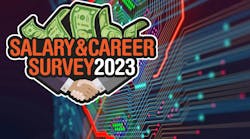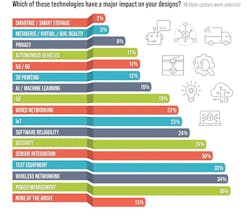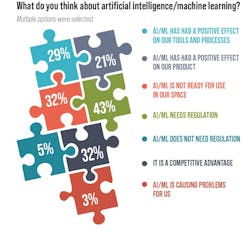AI’s Impact in the Engineering Workplace
This article is part of the Professional Advancement Series: Annual Salary Survey.
What you’ll learn:
- How engineers have adapted AI into the workplace.
- What are some of the advantages and disadvantages there are using AI.
- Insight into how engineers are impacted by AI in the workplace.
We know this: Artificial intelligence (AI) is a useful tool, time-saver, and a crutch in some cases. When some technological breakthrough rolls out, we instinctively gravitate to it and, in turn, becomes a part of our daily lives. Take the iPhone and subsequent touch-based phones that came afterward. They are, without a doubt, essential to our lives, fitting like a glove in how we access the world. And AI is following the same path.
Countless large data projects use AI to, for example, model molecules, detect cancerous cells, and/or enhance CRISPR tools or the production of biomolecules and materials. These are constantly running, constantly producing results that aren’t possible with humans. The world of electronics has embraced AI, like machine-learning applications, circuit design, simulation, etc. Take Synopsys DSO.ai, launched in 2020. It has already produced over 100 production tapeouts through increased workflow optimizations and reduced design times.
Such increased productivity and accuracies through AI come at a cost. CNN reported that 212,294 jobs were lost in the tech industry in 2023 due to AI. Goldman Sachs predicts that 300 million jobs will be impacted in the next five years (via Forbes).
This is what humans do, we use technology and displace the old ways. Over 200,000 elevator operator jobs were lost with the use of automatic elevators. It took years to replace all of those workers. AI, on the other hand, is hitting us all fast—11 months and over 200k jobs already gone.
That said, AI will steadily grow in the workplace, which is indicative of the numbers detailed in a 2022 report from Global Market Insights. According to the report, the AIU engineering market is expected to grow by 35% by 2032 with a market value of $180 billion, up from $8 billion in 2022. That number alone is striking, considering it’s a base driver for business expansion and long-term research projects in the AI engineering market.
Since ChatGPT launched, more engineers and companies have taken notice of AI’s potential, making it a top conversation across multiple industries and workplaces. From the instances of what ChatGPT has been used for in that time makes it easy to see why AI has been gaining momentum across the engineering fields.
How is AI Leveraged in the Workforce?
AI in the engineering workplace is broken down into hardware and software components. As machines become more sophisticated, they will support not only smart production lines and complex manufacturing tasks, but will also be able to design and improve tasks over time via machine learning (ML).
This is evident in many industries such as automotive and aerospace. However, it’s also becoming more beneficial in the design phase of other industries, including using ML to glean insights from other departments to make the design process more efficient with increased precision.
AI is also being leveraged in the electrical engineering field, with the most prominent being the automation of routine tasks, including those for circuit design, component selection, and system analysis. It’s also being used to provide new tools and techniques to aid in solving complex problems.
For example, engineers can use AI to create models that learn from data to make predictions based on a number of external factors, such as operating environments, temperatures, and power usage via simulations. Software engineers have taken advantage of AI to streamline repetitive coding tasks, including code conversion, converting data maps, and generating working unit tasks.
What Does the Survey Say?
According to a recent survey conducted by Electronic Design and others in the Endeavor Business Media group (Fig. 1), which polled engineers from diverse fields and garnered 1,977 responses, 21.25% stated AI and ML technologies have had a major impact on their designs. That’s a significant amount, especially for a diverse group, with most employed in the design and development fields.
Another good portion of those engineers polled currently design industrial control systems and equipment, areas where AI tools help streamline everything from component placement to predictive maintenance.
Of course, not all engineers see AI and ML as beneficial in the work environment. Among those polled, 7.46% have considered leaving the profession due to its impingement or the fear of eventually being replaced. These numbers aren’t a reflection of engineers on a national scale, but they do represent the notion that some do consider AI to be a detriment to the profession.
For example, the same survey shows that some businesses and companies are still evaluating the use of AI in their practices (Fig. 2), while a good portion don’t use it at all. Most feel that AI needs to be regulated before being implemented, while others say it provides a competitive advantage. Still, 3.59% feel AI is causing problems in the workplace or job functions.
Revolutionary—with Caveats
The integration of AI in the engineering workplace represents a transformative approach in much the same fashion as the industrial revolution, with its advantages and challenges. AI has provided engineers with powerful tools to automate tasks, optimize designs, and solve complex problems, which have led to increased efficiency and innovation. It has the potential to revolutionize the engineering fields, allowing workers to create complex projects at immense scales.
It also has its drawbacks, as AI raises concerns about privacy, security, and biases within the algorithms themselves. Ethics is also a serious concern, certainly when it pertains to intellectual and proprietary technologies and those who create them. These issues must be addressed—the concerns are valid and legal issues are already being scrutinized.
Ultimately, successful integration of AI in the engineering workplace will hinge on a thoughtful, ethical, and forward-thinking approach to maximize its benefits while mitigating its drawbacks. AI everywhere is an inevitability, but how we see it and use it will decide our fates.



